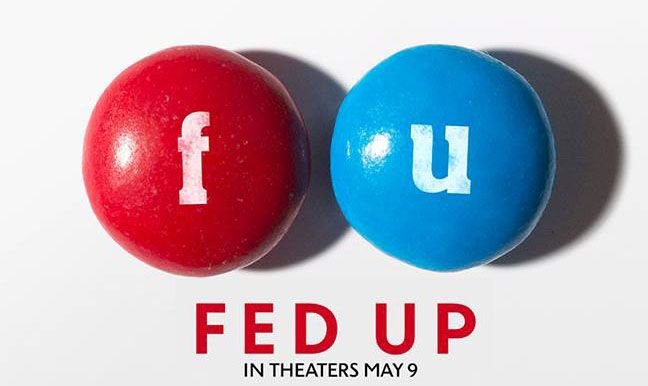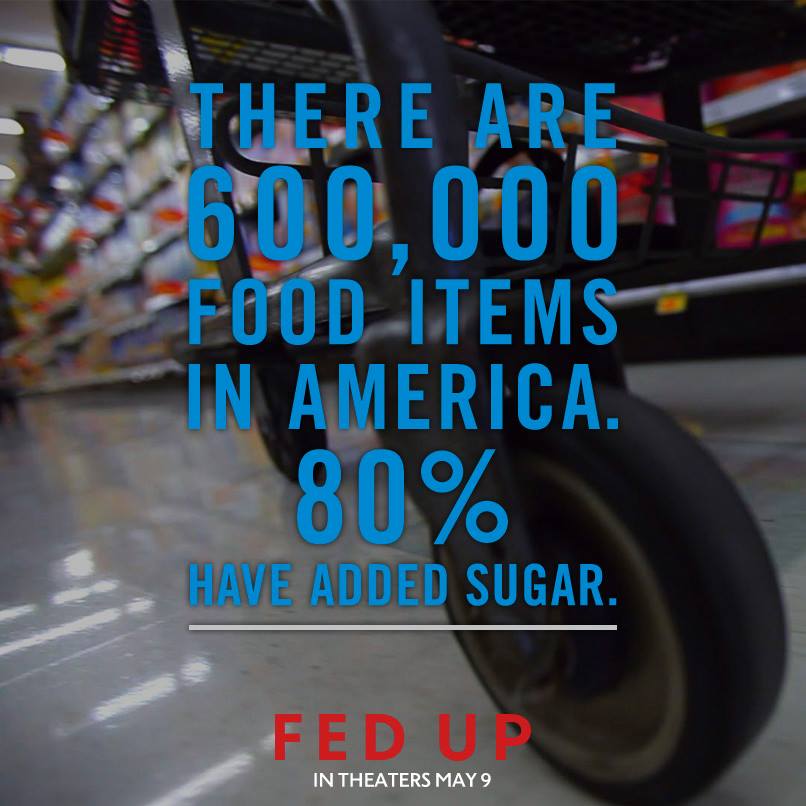It’s pretty shocking to think that in 2010, there were nearly 58,000 cases of Type 2 diabetes diagnosed in adolescents–while in 1980 there were zero. Zero. In fact, it used to be called Adult Onset Diabetes, which isn’t even accurate anymore. It’s equally shocking that we’re now at a point where more people in the world will die of obesity than starvation. And that’s what the Fed Up Movie, which opens in theaters tonight, explores and explains if uncomfortably at times.
If you have ever had trouble losing weight, if you have ever read a nutrition label, if you have ever talked disparagingly about someone overweight, then this movie is for you. Especially if you have children.
The movie is a fairly damning exposé that goes beyond what’s in the foods we eat; but rather offers a complete dissection of why obesity rates around the world have climbed at the same rate as the fitness craze–two seemingly incongruous statistics. The conclusions they draw are a little horrifying and a lot enlightening, and the resulting film is surprisingly emotional. Especially when we hear from 12 and 15-year-olds struggling with obesity themselves. Oof.
Produced by Laurie David and Katie Couric (who also narrates it beautifully) and directed by Stephanie Soechtig with the help of a remarkable advisory board, this movie will completely make you rethink the past 30 years of “givens” about diet and exercise. Among the ideas challenged by a whole lot of experts and scientists in the documentary:
-Counting calories is a smart way to control weight.
-Juice is better than soda.
-Fast food is cheaper than healthy food.
-Light foods or low-fat foods are better for you.
-Thin children are healthier.
-If overweight people worked out more they’d lose weight.
I mean, wow. Those are some major mindset shifts that this movie is going for.
It’s amazingly produced with some serious heavy hitters in this film, from Michael Pollan and Marion Nestle to Senator Tom Harkin and Bill Clinton, and their opinions and revelations are absolutely mindblowing.
Health insurance companies buying stock in fast food companies? Think about that one for a minute.
Of course there’s a lot about the politics of food and the food lobby, and the impossible task our government has of both advocating for better health for our children, while protecting the profits of big agro. But overall, it’s not a movie about politics; it’s a human story about children struggling with obesity in the most heartbreaking ways and what we can do to stop it.
Mostly, it’s about being an informed consumer so we can make better decisions, especially as parents.
From now on, I know I will think more about how much sugar is hidden in processed foods that we eat, from bread and cereal to peanut butter to pizza–which, you may know, has been classified as a vegetable, for the sake of our national school lunch program. (What you may not know is that was thanks to lobbying on behalf of the pizza manufacturer who supplies 75% of pizzas to the schools and didn’t want to take the hit. Too bad for you, kids!) From now on, I will know that even when I tell my kids “no dessert,” that doesn’t mean they haven’t already had more than their share of sugar for the day.
I will say there were a few vaguely conspiratorial references that made me raise an eyebrow (are formula companies really adding sugar to intentionally get babies addicted to it?) but a lot of the evidence is disturbingly sound. I also think that high-fructose corn syrup got off pretty easy here but that’s another story. And while there’s a slight partisan slant as you can imagine when you’re talking public health vs big business, they really do give it to both sides equally.
You get the distinct feeling that the filmmakers aren’t advocating for any one political stance, but for our children overall, and I really appreciate that.
Look, I’m not going to completely stop baking cookies or giving my kids snacks they love, or drinking the occasional soft drink. I’ve always been an advocate of “everything in moderation,” and frankly, a life without black-and-white milkshakes would be a sad one. But I am glad I can be better aware of how much sugar is in the other things I eat, so that when I tell myself, I’ve been good today, I’m not lying to myself.
I’d say this is even a film you can bring kids to, to open up some great discussions yourself. (No Food Inc. style slaughterhouses here.) My own six and eight-year olds were reluctant to watch the screener with me at first, but eventually they were begging me not to turn it off at bedtime. It’s really that compelling and easy to watch.
Perhaps the best part: This morning, my eight-year-old said, “now I understand why you tell us to have milk instead of juice at dinner.” And I wanted to cry.
If my own typically American, mac-n-cheese loving children end up making better choices for themselves when it comes to food, especially when I’m not around, well then, thank you Fed Up. You’ll have made a huge difference for me, at least.
Learn more about the Fed Up Movie at their website, and in theaters across the country starting today.






Sounds really interesting, and I’m glad to hear it omits the “slaughterhouse” style of Food, Inc, but why couldn’t they have just released this to On Demand instead of the movie theater? I think their marketing team missed the boat on that part.
Good question Monica. I know it was screened at Sundance and I’d assume they’re going for award show consideration (and hopefully more profits/eyeballs) with a limited theatrical release. No doubt it will hit the streaming video circuit soon, as docs often do. Hope you get a chance to see it.
This is so sad, and so scary.
You know, 6 months ago, I would have been a total spazz throwing everything in our pantry and freezer away.
I am so glad that I have a solution for my families nutrition.
Why is there one teaspoon of sugar every five ounces in some baby formulas? Why are there four types of added sugars in some formulas? Why would the first ingredient listed on a baby formula be corn syrup solids? It certainly isn’t for the health of the babies, and Europe has seen this and banned some added sugars in baby formulas still allowed in the U.S., seeing as the FDA doesn’t even so much as require grams of sugar to be on the nutrition label. Why in the world would companies be making these “baby milkshakes” so chock full of sugar, containing sugars that behave differently than lactose in the body, and having significantly more sugar and calories than breast milk? Why would you approach the question as to why big companies are loading their products with sugar any differently for one type of food than another? Because corporations and sugar companies care so much about children?
Source: https://www.nbcchicago.com/investigations/target-5-sugar-baby-formula-139339308.html#ixzz3Y62507lp
—-
EDS: More info from the same article about specific brands of formula:
Enfamil Premium and Parent’s Choice premium infant formulas had the highest sugar content, at 13.5 and 12.4 grams per serving. The amounts are high but experts say the type of sugar revealed is the best: lactose, the same type found in breast milk.
Three brands tested low for any sugar: Gerber Good Start, Similac Advance Complete and Enfamil Pro-Sobee.
Conversely, in two types of formula made by Similac, the test revealed other added sugars….
The maker of Enfamil said it does not include any added sugars, including sucrose, because they are not found in breast milk. The maker of Parents Choice echoed that philosophy.